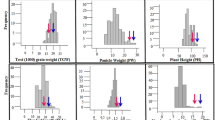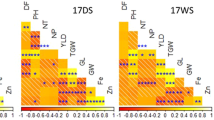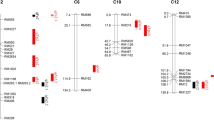Abstract
Rice protein content (RPC) and rice fatcontent (RFC) are two important componentsof rice nutritional quality. In order toexamine the genetic basis of these traits,a doubled haploid (DH) population and anRFLP linkage map consisting of 232 markerloci were used to search QTLs for thetraits with the computer programQTLMapper1.0. This program is based onmixed linear models and allows simultaneousmapping of both main-effect and digenicepistastic QTLs in a DH population. RPC andRFC were evaluated based on a dry weightbasis of head rice by the Kjeldahl andSoxhlet methods respectively. A total offive main-effect QTLs for RPC wereresolved. The five QTLs collectivelyexplained 74% of the phenotypic variationwith LOD=15.2. Among these QTLs, the majorQTL qRPC-5 with the largest effectwas mapped in the interval of RG435-RG172aon chromosome 5. It accounted for 35% ofthe phenotypic variation with a LOD of16.7. At this locus the allele from theparent `Gui 630' increased RPC by 1.32%.The second QTL qRPC-7 was mapped inthe interval ZG34B-G20 on chromosome 7. Itexplained 23% of the phenotypic variancewith a LOD of 6.1. Its positive alleles,also from the parent `Gui 630', increasedRPC by 1.05%. As for the remaining threeQTLs, their additive effects wererelatively small and their positive alleleswere all inherited from the parent `02428'.Three QTLs for RFC were mapped onchromosome 1, 2 and 5 respectively. Theycollectively explained 44% of thephenotypic variation. Among these loci,QTLs qRFC-2 and qRFC-5 withlarger effects individually accounted for24% and 26% of the phenotypic variancerespectively. At QTL qRFC-2 thepositive allele came from the parent `Gui630', while at QTL qRFC-5 thepositive allele from the parent `02428'.The fact that both parents possess thepositive alleles at the QTLs for the twotraits provides an appropriate explanationfor the large transgressive segregationobserved in the DH lines. Furthermore, onlyone pair of epistatic loci explaining only5.1% of the phenotypic variance wasdetected for RPC, whereas seven pairs ofepistatic loci were resolved for RFC. Thetotal absolute effects of these RFCinteractions amounted to 0.97% which ismuch larger than that (0.42%) of the threemain-effect QTLs for the trait. Alongwith the observation that RPC showed a highheritability (78%), these resultsdemonstrate that RPC in the DH populationcould be mainly controlled by relativelyfew QTLs with large main-effects. As forRFC, epistatic interactions might be aneven more important component of thegenetic basis and the segregation of the DHlines could be largely explained by a fewmain-effect QTLs and many epistatic loci.In addition, a highly negative correlation(r = –0.45) between RPC and RFC inthe DH population was observed. Thiscorrelation could be largely explained bythe linkage of qRPC-5 and qRFC-5 with the directions of effectsopposite and the co-locations of the twoepistatic loci for RFC respectively withtwo different main-effect QTLs for RPC. Theinformation reported in the present papermay be useful for improving ricenutritional quality by means ofmarker-assisted selection.
Similar content being viewed by others
References
Bogyo, T.P., R.C.M. Lance, P. Chevalier & R.A. Nilan, 1988. Genetic models for quantitatively inherited endosperm characters. Heredity 60: 61–67.
Chen, J.G. & J. Zhu, 1998. Genetic analysis of fat content in indicajaponica intersubspecific hybrid rice. J Trop Subtrop Bot 6(4): 347–351.
Edwards, M.D., T. Helentjaris & S. Wright, 1992. Molecularmarker-facilitated investigations of quantitative trait loci in maize. 4. Analysis based on genome saturation with isozyme and restriction fragment length polymorphism markers. Theor Appl Genet 83: 765–774.
Foolad, M.R. & R.A. Jones, 1992. Models to estimate maternally controlled genetic variation in quantitative seed character. Theor Appl Genet 83: 360–366.
Goldman, I.L, T.R. Rocheford & J.W. Dudley, 1993. Quantitative trait loci influencing protein and starch concentration in the Illinios long term selection maize strains. Theor Appl Genet 87: 217–224.
Goldman, I.L, T.R. Rocheford & J.W. Dudley, 1994. Molecuar markers associated with maize kernel oil concentration in an Ilinois high and Ilinois low protein cross. Crop Sci 34: 908–915.
Hamaker, B.R. & V.K. Griffin, 1990. Changing the viscoeleastic properties of cooked rice through protein disruption. Cereal Chem 67: 261–264.
Hamaker, B.R. & V.K. Griffin, 1991. Potential influence of a starch granule-associated protein on cooked rice stickiness. J Food Sci 56: 1327–1329.
Hu, Z.L., 1987. A genetic analysis of some qualitative characters in rapeseed (Brassica napus L.). Oil Crops of China 1: 19–22. (In Chinese with English abstract)
Juliano, B.O., 1985. Rice Chemistry and Technology, 2nd edn. American Association of Cereal Chemists, St. Paul, Minnesota.
Juliano, B.O., 1993. Rice in Human Nutrition. FAO Food Nutrition Series No. 26. International Rice Research Institute, Manila, The Philippines.
Lander, E.S. & D. Botstein, 1989. Mapping Mendelian factors underlying quantitative traits using RFLP linkage maps. Genetics 121: 185–199.
Li, P., L.H. Zhu, K.D. Zhou, Y. Chen, C.F. Lu & P. He, 1996. Genetic mapping of rice using RFLP markers and a double haploid population of a cross between indica and japonica varieties. Acta Botanica Sinica 38(11): 881–886 (In Chinese with English abstract).
Li, Z.K., S.R.M. Pinson, M.A. Marchetti, J.W. Stansel & W.D. Park, 1995. Identification of quantitative trait loci for heading date and plant height in cultivated rice (Oryza sativa L.). Theor Appl Genet 91: 374–381.
Li, Z.K., S.R.M. Pinson, A.H. Paterson, W.D. Park & J.W. Stansel, 1997. Epistasis for three grain yield components in rice (Oryza sativa L.). Genetics 145: 453–465.
Lin, R., Y. Luo, D. Liu & C. Huang, 1993. Determination and analysis on principal qualitative characters of rice germplasm. In: C. Ying (Ed.), Rice Germplasm Resources in China, pp. 83–93. Agricultural Science and technology Publisher of China, Beijing.
Lincoln, S.,M. Daly & E. Lander1992. Mapping genes controlling quantitative traits with MAPMAKER/QTL 1.1.Whitehead Institute Technical Report, Cambridge, Massachusetts.
McCouch, S.R., Y.G. Cho, M. Yano, E. Paul, M. Blinstrub, H. Morishima & T. Kinoshita, 1997. Report on QTL nomenclature. Rice Genet Newsl 14: 11–13.
Perez, C.M., B.O. Juliano, S.P. Liboon, J.M. Alcantara & K.G. Cassman, 1996. Effects of late nitrogen fertilization application on head rice yield, protein content, and grain quality of rice. Cereal Chem 73: 556–560.
Qi, Z. & B. Li, 1983. A study on the genetic of exterior quality and fat of the rice grains. Acta Genetica Sinica 10(6): 452–458.
SAS institute, Inc., 1996. SAS Users Guide: Statistic. SAS Institute, Cary, NC.
Sebolt, A.M., R.C. Shoemaker & B.W. Diers, 2000. Analysis of a quantitative trait locus allele from wild soybean that increases seed protein concentration in soybean. Crop Sci 40: 1438–1444.
Shenoy, V.V., D.V. Seshu & J.K.S. Sachan, 1991. Inheritance of protein per grain in rice. Indian J Genet 51(2): 214–220.
Shi, C.H., J. Zhu, X.E. Yang, Y.G. Yu & J. Wu, 1999. Genetic analysis for protein content in indica rice. Euphtica 107(2): 135–140.
Tan, Y.F., J.X. Li, S.B. Yu, Y.Z. Xing, C.G. Xu & Qifa Zhang, 1999. The three important traits for cooking and eating quality of rice grains are controlled by a single locus in an elite rice hybrid, Shanyou 63. Theor Appl Genet 99: 642–648.
Tan, Y.F., M. Sun, Y.Z. Xing, J.P. Hua, X.L. Sun, Q.F. Zhang & H. Corke, 2001. Mapping quantitative trait loci for milling quality, protein content and color characteristics of rice using a recombinant inbred line population derived from an elite rice hybrid. Theor Appl Genet 103: 1037–1045.
Tanksley, S.D., 1993. Mapping polygenes. Annu Rev Genet 27:205–233.
Wang, D.L., J. Zhu, Z.K. Li & A.H. Paterson, 1999. Mapping QTLs with epistatic effects and QTL × environment interactions by mixed linear model approaches. Theor Appl Genet 99: 1255–1264.
Wilcox, J.R. & R.M. Shibles, 2001. Interrelationship among seed quality attributes in soybean. Crop Sci 41: 11–14.
Xiao, J., J. Li, L. Yuan & S.D. Tanksley, 1996. Identification of QTLs affecting traits of agronomic importance in a recombinant inbred population derived from a sub-specific rice cross. Theor Appl Genet 92: 230–244.
Xu, C.W., X.H. He, J.M. Kuai & S.L. Gu, 2001. Mapping quantitative trait loci underlying endosperm traits in cereals. Scienta Agricultura Sinica 34(2): 117–122.
Xu, Y.B., 1997. Quantitative trait loci: separating, pyramiding and cloning. Plant Breed Rev 15: 85–39.
Yano, M., Y. Harushima, Y. Nagamura, N. Kurata, Y. Minobe & T. Sasaki, 1997. Identification of quantitative trait loci controlling heading date of rice using a high density linkage map. Theor Appl Genet 95: 1025–1032.
Zhang, Z.H., P. Li, L.X. Wang, C.J. Tan, Z.L. Hu, Y.G. Zhu & L.H. Zhu, 2002. Identification of quantitative trait loci (QTLs) for the characters of vascular bundles in peduncle related to indicajaponica differentiation in rice (Oryza sativa L.). Euphytica 128: 279–284.
Rights and permissions
About this article
Cite this article
Hu, ZL., Li, P., Zhou, MQ. et al. Mapping of quantitative trait loci (QTLs) for rice protein and fat content using doubled haploid lines. Euphytica 135, 47–54 (2004). https://doi.org/10.1023/B:EUPH.0000009539.38916.32
Issue Date:
DOI: https://doi.org/10.1023/B:EUPH.0000009539.38916.32




